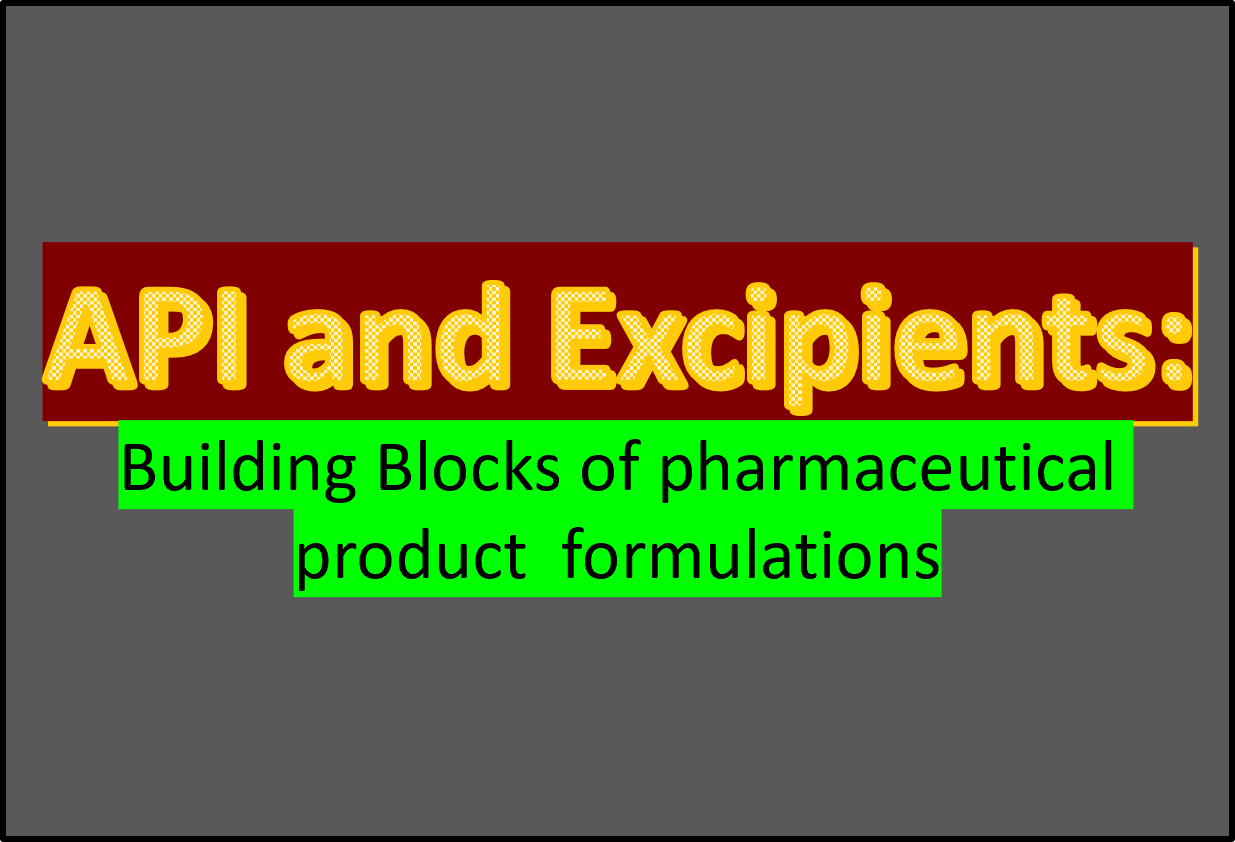API and Excipients: The Building Blocks

This article describes information about API and excipients, Its difference among them, importance of API and excipients in the pharmaceutical product formulations.
API and Excipients: The Building Blocks of Pharmaceutical Formulation
API and Excipients in Pharma Industry :
Two essential and key components in the manufacturing of drugs are Active Pharmaceutical Ingredients (APIs) and excipients. APIs are the biologically active component of a drug responsible for its therapeutic effect and excipients are non-active ingredients that aid in the manufacture, delivery, and administration of the drug. These two terms are often used interchangeably, but they have different functions and roles in the pharmaceutical industry.
What is mean by API ?
API stands for Active Pharmaceutical Ingredient. It is the part of the drug that has a therapeutic effect on the body. It is the biologically active component responsible for the treatment or prevention of a specific disease or condition. In other words, it is the part of the drug that makes it work.
There are two main types : synthetic and natural. Synthetic Active pharmaceutical ingredient (APIs) are made through chemical processes in a laboratory. Natural APIs are derived from natural sources, such as plants or animals. it can be further classified based on their chemical structure, mechanism of action, and therapeutic use.
The manufacturing process of APIs is complex and requires a high level of expertise. It involves the synthesis or extraction of the active ingredient, as well as purification and formulation. Regulations and quality control measures are in place to ensure the safety and efficacy of Active pharmaceutical ingredients in pharmaceutical products.
What is an Excipient?
Excipients are non-active ingredients that are added to drugs to aid in their manufacture, delivery, and administration. They are the components of a drug that are not intended to have any therapeutic effect on the body. Excipients can be used to improve the stability, solubility, bioavailability, and appearance of a drug.
There are many different types of excipients, including fillers, binders, lubricants, and coatings. Excipients can be derived from a variety of sources, including natural, synthetic, and semi-synthetic materials.
The manufacturing process of excipients is also complex and requires a high level of expertise. Excipients must be carefully selected and tested for compatibility with the API and other excipients in the drug formulation. Regulations and quality control measures are in place to ensure the safety and efficacy of excipients in pharmaceutical products.
Difference Between API and Excipients
The main difference between API and excipients is their function and purpose. Active pharmaceutical ingredients are the biologically active component of a drug that has a therapeutic effect on the body. Excipients, on the other hand, are non-active ingredients that aid in the manufacture, delivery, and administration of the drug.
Another difference between API and excipients is their manufacturing and regulation. The manufacturing process of Active pharmaceutical ingredients is more complex and requires a higher level of expertise than the manufacturing of excipients. Regulations and quality control measures are in place to ensure the safety and efficacy of both Active pharmaceutical ingredients and excipients in pharmaceutical products. The regulatory framework for APIs is more strict compared to excipients due to their active role in the drug formulation.
Examples of API and excipients usage in pharmaceuticals include Azithromycin (Antibiotic), Diclofenac (painkillers), Paracetamol (Antipyretic) etc. The API is responsible for the therapeutic effect, while the excipients are added to improve the drug’s stability, solubility, and appearance examples of excipients are Lactose, Microcrystalline cellulose (Diluent), Povidone (Binder), Magnesium stearate (Lubricant) . In vaccines, the Active pharmaceutical ingredients is the antigen that triggers an immune response, while the excipients are added to improve the vaccine’s efficacy and delivery.
Importance of API and Excipients in the Pharmaceutical Industry
API and excipients play a crucial role in the pharmaceutical industry. They are key components in the drug formulation and delivery process, and they have a significant impact on drug efficacy and safety. Both components must be carefully selected and tested for compatibility with each other and the drug formulation to ensure optimal drug delivery and therapeutic effect.
The role of API and excipients in drug formulation and delivery can also impact the cost of pharmaceutical products. The cost of Active pharmaceutical ingredients can be high due to their complex manufacturing process and regulatory requirements. The use of excipients can help reduce costs by improving drug stability and bioavailability, thereby reducing the amount of Active pharmaceutical ingredients needed for the drug to be effective.
Frequently Asked Questions (FAQs) :
-
What is the main difference between API and excipients?
- The main difference between Active pharmaceutical ingredient and excipients is their function and purpose. Active pharmaceutical ingredients are the biologically active component of a drug responsible for its therapeutic effect, while excipients are non-active ingredients that aid in the manufacture, delivery, and administration of the drug.
-
Why are APIs more strictly regulated compared to excipients?
- Active pharmaceutical ingredients are more strictly regulated compared to excipients due to their active role in the drug formulation. Active pharmaceutical ingredient (APIs) require a complex manufacturing process and must undergo rigorous quality control measures to ensure their safety and efficacy.
-
What is the impact of API and excipients on drug efficacy and safety?
- Active pharmaceutical ingredients and excipients have a significant impact on drug efficacy and safety. They must be carefully selected and tested for compatibility with each other and the drug formulation to ensure optimal drug delivery and therapeutic effect.
-
How do excipients help reduce the cost of pharmaceutical products?
- Excipients can help reduce the cost of pharmaceutical products by improving drug stability and bioavailability, thereby reducing the amount of Active pharmaceutical ingredients needed for the drug to be effective.
-
What are some examples of API and excipients used in pharmaceutical products?
- Examples of APIs and excipients used in pharmaceutical products include Azithromycin (Antibiotic), Diclofenac (painkillers), Paracetamol (Antipyretic) etc and examples of excipients includes Lactose, Microcrystalline cellulose (Diluent), Povidone (Binder), Magnesium stearate (Lubricant) respectively.
Abbreviations :
API : Active Pharmaceutical Ingredient


